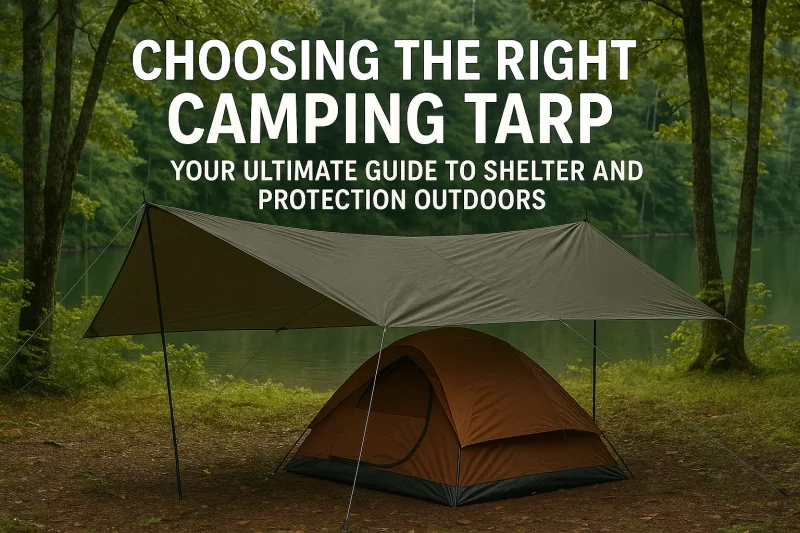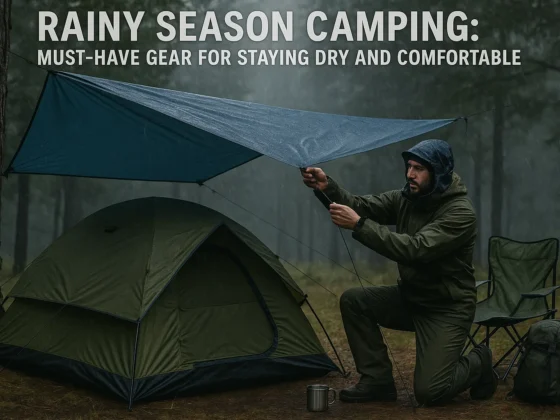A good adventure begins with preparation—and for every camper, one piece of gear that often gets overlooked yet proves invaluable in the wild is the humble tarp. A camping tarp is more than a simple sheet of fabric. It’s your portable roof, ground protector, makeshift kitchen shade, and emergency shelter all in one. Whether you’re setting up camp under the tropical skies of Batangas, hiking through the Cordilleras, or braving the unpredictable weather of Mt. Apo, a reliable tarp can make or break your trip.
In the Philippines, where sudden rain showers and intense sun are part of the outdoor experience, having a durable tarp is practically non-negotiable. Yet, many beginners underestimate how much comfort and safety depend on this versatile tool. The right one can shield your gear, prevent tent leaks, and create a communal space that feels like home even in the middle of nowhere.
This comprehensive guide dives deep into everything you need to know—from understanding materials and shapes to mastering the art of setup and maintenance. Whether you’re a seasoned mountaineer or a weekend camper, this article will help you choose the right tarp for your next adventure with confidence.
1. What Is a Camping Tarp and Why It Matters
At its core, a camping tarp is a waterproof or water-resistant sheet made from durable materials like polyester, nylon, or polyethylene. But it’s also one of the most flexible pieces of camping equipment you can own. It can serve as a rainfly, groundsheet, windbreaker, or sunshade.
The beauty of a tarp lies in its adaptability. When you’re caught in heavy rain and your tent starts leaking, you can quickly rig a tarp over it. When the ground is muddy, it becomes a clean base for sitting or cooking. For backpackers, it doubles as a lightweight alternative to tents—ideal for minimalist camping or emergency use.
2. Common Types of Camping Tarps
Not all tarps are created equal. Understanding their different types helps you choose one that best suits your camping style.
a. Flat Tarps
-
Traditional rectangular or square tarps.
-
Extremely versatile—can be pitched in multiple configurations (A-frame, lean-to, or diamond fly).
-
Great for experienced campers who like flexibility.
b. Catenary-Cut Tarps
-
Edges are curved for a tauter pitch and less flapping in the wind.
-
Ideal for lightweight backpacking and minimalist shelters.
c. Hexagonal Tarps
-
Often used with hammocks for streamlined coverage.
-
Easy to tension and stable in windy conditions.
d. Tent-Compatible Tarps
-
Designed to match specific tents or brands.
-
Offers extended coverage for gear and cooking areas.
e. Multi-Purpose Tarps
-
Heavier but more affordable options made from PE or PVC.
-
Perfect for casual campers or vehicle-based camping.
3. Materials That Make or Break a Tarp
A tarp’s durability and performance largely depend on its material. Here’s what to consider:
| Material | Pros | Cons |
|---|---|---|
| Nylon | Lightweight, flexible, and durable. Often coated with silicone or polyurethane for waterproofing. | Can stretch when wet. |
| Polyester | UV-resistant, doesn’t stretch easily, and holds color well. | Slightly heavier than nylon. |
| Polyethylene (PE) | Budget-friendly, waterproof, and tough. | Bulky and prone to tearing with heavy use. |
| Canvas | Breathable and very strong. | Heavy and needs maintenance to stay waterproof. |
For tropical climates like the Philippines, polyester and nylon offer the best balance of durability, water resistance, and portability.
4. Size and Shape: Getting the Dimensions Right
The ideal tarp size depends on your intended use and number of campers.
-
Solo campers: 2×3 meters is usually sufficient.
-
Two to four people: Go for 3×4 meters or larger.
-
Family or group camping: 4×4 meters and beyond ensures ample shade and space.
As for shape, rectangular and square tarps provide the most pitching options. Hexagonal ones are preferred for hammock setups, while irregular cuts can be used for creative configurations.
Pro tip: Always choose a tarp slightly bigger than you think you’ll need—it’s easier to fold down excess coverage than to stretch a small one too far.
5. Essential Features to Look For
When browsing for tarps, consider these features as must-haves:
-
Reinforced Grommets: Prevent tearing when tensioned.
-
Waterproof Coating: PU or silicone coatings improve weather resistance.
-
UV Protection: Essential for long-term exposure under tropical sun.
-
Taped or Heat-Sealed Seams: Keeps rain from seeping through.
-
Guy Lines and Tie-Out Points: More anchor points mean more setup options.
-
Stuff Sack or Carry Bag: Makes transport and storage convenient.
These small details can drastically impact your tarp’s longevity and performance, especially in unpredictable weather.
6. Setup Configurations and Their Uses
One of the joys of using a camping tarp is experimenting with different setups. Here are a few common configurations:
-
A-Frame Pitch: Classic tent-like shape ideal for rain protection.
-
Lean-To Shelter: Great for cooking areas or open fronts facing a campfire.
-
Diamond Fly: Efficient rain coverage for hammocks.
-
Flat Roof: Provides large shaded space for groups or picnic areas.
-
Groundsheet Mode: Place under your tent or sleeping bag for insulation and cleanliness.
Mastering these setups gives you the freedom to adapt to your surroundings, terrain, and weather.
7. Practical Tips for Tarp Setup and Maintenance
A few small habits can go a long way in ensuring your tarp lasts:
-
Use non-stretch cords or adjustable tensioners for easy adjustments.
-
Avoid pitching under sharp branches or rocks that can puncture fabric.
-
Dry the tarp completely before storing to prevent mildew.
-
Reapply waterproofing spray once a year or as needed.
-
Clean with mild soap—avoid harsh detergents that degrade coatings.
With the right care, a quality tarp can last for years, accompanying you on countless camping trips.
8. The Role of a Camping Tarp in the Philippine Setting
Camping in the Philippines often means dealing with sudden weather shifts—clear skies one minute, torrential downpour the next. A tarp isn’t just a comfort item; it’s a survival tool.
Imagine camping in Zambales during the Amihan season. The sun can be harsh during the day, but rain can strike in the afternoon. A tarp over your tent offers extra insulation against heat and prevents moisture from seeping in. In coastal camps like Calaguas or Baler, it doubles as a windbreak and sand shield.
For local campers, it’s not about having the fanciest gear—it’s about practical adaptability, and that’s where a good tarp shines.
9. Buying Guide: How to Choose the Best Camping Tarp
Choosing a tarp goes beyond aesthetics. Here’s a quick guide to help you decide:
a. Assess Your Camping Style
-
Backpackers need lightweight and compact tarps (nylon or catenary-cut).
-
Car campers can go for heavier, multi-purpose ones for durability.
-
Hammock campers should prioritize shape (hex or diamond cuts).
b. Consider Weather and Environment
-
For tropical climates, look for UV-resistant and waterproof tarps.
-
For mountain camping, windproof design and strong grommets are crucial.
c. Check Build Quality
Inspect stitching, grommet reinforcements, and coatings. Double-stitched hems indicate premium craftsmanship.
d. Evaluate Portability
The tarp should be easy to fold and store. Lightweight models with carrying pouches are ideal for travel.
e. Set a Realistic Budget
You don’t need to buy the most expensive tarp, but avoid the cheapest ones. Think of it as a long-term investment in safety and comfort.
A great example of a well-balanced tarp is the camping tarp from Uniflame—crafted with durable materials, built-in UV protection, and designed for effortless setup. It’s the kind of gear that works for both casual campers and seasoned outdoorsmen.
10. Alternatives and Accessories to Pair with Your Tarp
Your tarp works best when paired with the right accessories:
-
Paracord or Guy Lines: For secure tensioning.
-
Tent Stakes or Pegs: To anchor corners firmly on any terrain.
-
Poles or Trekking Sticks: Useful for adjustable setups.
-
Carabiners and Clips: Simplify attachment points.
-
Ground Pads or Footprints: Add insulation and prevent slippage.
These accessories enhance your setup’s stability and expand your tarp’s versatility.
Conclusion
A camping tarp might seem like a simple addition to your gear, but it’s one of the most powerful tools for transforming a trip from basic to brilliant. With the right tarp, you gain not just shelter—but flexibility, safety, and peace of mind.
Think of it as your camp’s first line of defense and your comfort zone rolled into one. Whether shielding your tent from rain, creating shade for cooking, or forming a communal spot for your group, the right tarp adapts to your needs and environment effortlessly.
So before your next adventure, make sure to invest in quality gear that can stand up to the Philippines’ unpredictable outdoors. When chosen wisely and cared for properly, a tarp won’t just protect you—it will redefine the way you experience the wild.


